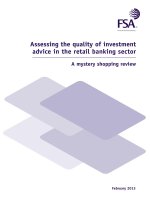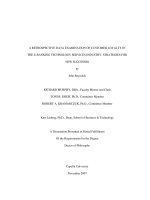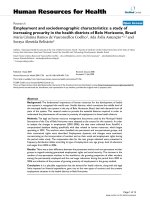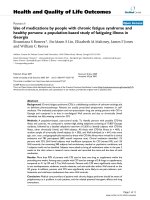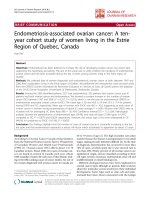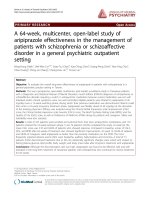A com parative study of financial performmance in the Vietnammese banking sector evidence for vietnamese leading joint stock commercial nanks Luận văn thạc sĩ
Bạn đang xem bản rút gọn của tài liệu. Xem và tải ngay bản đầy đủ của tài liệu tại đây (3.14 MB, 94 trang )
MINISTRY OF EDUCATION & TRAINING
HOCHIMINH CITY UNIVERSITY OF ECONOMICS
Nguyen Huu Nhan
Ho Chi Minh City – December, 2010
MINISTRY OF EDUCATION & TRAINING
HOCHIMINH CITY UNIVERSITY OF ECONOMICS
Nguyen Huu Nhan
Specialized in Banking & Finance
THE RESEARCH ADVISOR: VUONG DUC HOANG QUAN, Ph.D
Ho Chi Minh City – December, 2010
First of all, I would like to thank my supervisor Dr. Vuong Duc Hoang Quan,
whose never-ending optimism and patience encouraged me to continue on my
path. I appreciate very much the fact that Dr. Vuong Duc Hoang Quan took the
time to listen, discuss and help me fulfill this research.
I would like to thank to the Banking Faculty, which support me to finish this
thesis. My sincere thanks to Mr. Vo Xuan Vinh, Mr Dao Trung Kien for their
supports during my hard time of study.
Finally, I would like to say thanks to my family, who always support and
motivate me all the life.
Ho Chi Minh City,
Nguyen Huu Nhan
The purpose of this study is to classify the Vietnam commercial joint stock banks
in cohesive categories on the basis of their financial characteristics revealed by
the financial ratios. These financial characteristics are total assets, total
shareholder’s equity, loans to customers, deposit from customers and the
financial ratios such as probability, asset quality, operational efficiency and
liquidity ratios.
A sample of seven large Vietnam commercial joint stock banks total loans to
customers comprise of 63% of total outstanding loans of the whole Vietnam
commercial joint stock bank were financially analyzed, and simple regression
was used to estimate the impact of asset management, operational efficiency,
and bank size on the financial performance of these banks.
The study found that the bank with higher total capital, deposits, credits, or total
assets does not always mean that has better profitability performance. The
regression analysis results showed that financial performance of the bank was
not strongly and positively affected by the operational efficiency, the asset
management and the bank size.
ACB : Asia Commercial Joint Stock Bank.
AFTA : ASEAN Free Trade Area.
AHP model : Analytical Hierarchy Process.
ALM : Asset and Liability Management.
ANOVA : Analysis of variance.
ASEAN : Association of South East Asian Nations.
ATM : Automated Transaction (or Teller) machine.
AVSC : Au Viet Securities Co.
BDD : Bad and doubtful debt.
BSC : BIDV Securities Company.
CAMELS model : Capital, Asset Quality, Management, Earning, Liquidity,
Sensitivity to Market Risk.
CAR : Capital Adequacy Ratio.
CIC : Credit Information Center.
EAGLES model : Earning ability, Asset quality, Growth rates, Liquidity,
Equity level and capital adequacy, effective management-
SRQ.
Eximbank (EIB) : Vietnam Export Import Commercial Joint Stock Bank.
GSO : General Statistics Office of Vietnam
IOR : Income/Overheads ratio.
IPO : Initial Public Offering.
JSCB : Joint Stock Commercial Bank.
KPMG : KPMG Consulting Inc.
LDR : Loans to deposits ratio
Military Bank (MB) : Military Commercial Joint Stock Bank.
NIM : Net interest margin.
POS : Point of sale.
RAROC : Risk-adjusted return on capital.
ROA (A) : Return on assets (average).
ROE (A) : Return on equity (average).
ROSF : Return on Shareholder’s Fund.
Sacombank (STB) : Sai Gon Thuong Tin Commercial Joint Stock Bank.
SBV : State Bank of Vietnam
SOCB : State-owned Commercial Bank
SRQ : Strategic response quotient.
SWOT : Strengths, Weaknesses, Opportunities, and Threats.
Techcombank (TCB): Vietnam Technological and Commercial Joint Stock Bank.
Vietcombank (VCB) : Joint Stock Commercial Bank For Foreign Trade of Vietnam.
Vietinbank (CTG) : Vietnam Joint Stock Commercial Bank for Industry and
Trade.
VND : The currency of Vietnam.
WTO : World Trade Organization.
ACKNOWLEGEMENTS
ABSTRACT
ABBREVIATIONS
CONTENTS
LIST OF TABLES
LIST OF FIGURES
1.1. Background 1
1.2. Rationale of the study 3
1.3 Problem statement 3
1.4 Overall objective 3
1.5 Specific objectives 4
1.6 Scope and limitation 4
1.7 Structure of the thesis 4
2.1 Evaluating bank financial performance 6
2.1.1 Financial performance 6
2.1.2 Profitability 7
2.1.3 Capitalization 7
2.1.4 Asset quality 8
2.1.5 Operating efficiency 8
2.1.6 Liquidity 9
2.1.7 Other financial ratios 9
2.2 Asset and liability management (ALM) 10
2.3 Some models used in assessing the performance of bank 11
2.3.1 CAMELS model 11
2.3.2 SBV’s bank assessing framework 12
2.3.3 The EAGLES model 12
2.4 Some previous researches 13
2.5 Summary 15
3.1 Research framework 17
3.1.1 Suggested model in assessing and comparing banks 19
3.1.2 Financial indicators and ratios used in comparing banks 19
3.1.3 Variables 23
3.1.4 Hypothesis 24
3.2. Data for the study 25
3.2.1 Sampling 25
3.2.2 Data gathering 26
3.2.3 Data level of confidence 28
3.2.4 Data analysis 28
4.1. Comparisons of Vietnam leading joint stock commercial banks 30
4.1.1 Total assets 30
4.1.2 Total shareholder’s equity 32
4.1.3 Loans to customers 34
4.1.4 Deposits from customers 37
4.1.5 Return on total assets – ROAA 39
4.1.6 Return on shareholder’s equity – ROEA 41
4.1.7 Efficiency ratio 42
4.1.8 Asset quality 43
4.1.9 Liquidity 45
4.1.10 Ranks of chosen commercial banks 47
4.2 Hypotheses Testing 53
4.2.1 Relationships among the financial performance measured by ROA, and interest
income size, and the independent variables (operational efficiency, asset management,
bank size). 54
4.2.2 Independent variables impact on financial performance measured by ROA and
interest income size 56
5.1 Conclusions 61
5.2 Implications 63
5.3 Recommendations for further study 63
REFERENCES
: Selected financial criteria and ratio for the comparison and ranking 20
: Selected variables in testing hypothesis 24
Total outstanding loans 25
Selected commercial banks to compare 26
: Data source to extract and calculate financial ratios 27
: Total assets of commercial banks 30
: Total shareholder’s equity 32
: Loans to customers 36
: Deposits from customers 38
: Return on total assets – ROAA 39
: Return on shareholder’s equity – ROEA 41
: Net interest income/total operating expenses 42
Provisions for loans losses ratio 44
: Loans to deposits 45
: Ranks of chosen commercial banks based on financial indicators 47
: Chosen commercial banks: Key average data (2004-2009) 54
: Correlations results 56
: (ANOVA) independent variables impact on financial performance
measured by ROA and interest income size 57
: Research framework
: Suggested model in assessing and comparing banks 19
: Positive orrelations between variables 24
: The impact of asset management, operational efficiency and the
bank’s size on the financial performance 25
Individual bank’s asset growth 31
: Total assets of commercial Banks 32
: Total shareholder’s equity 34
: Assets – Loans growth 35
: Loans to customers 37
: Deposits from customers 38
: Return on total assets – ROAA 40
: Return on shareholder’s equity – ROEA 42
: Net interest income/total operating expenses 43
Provisions for loans losses ratio 44
: Loans, deposits growth 46
: Loans to deposits 46
________________________________ 1 ________________________________
_________________________________________________________________________
This chapter presents the overview of the study, including the background,
rationale of the study, overall and specific objectives, scope and limitation. At
the end of the chapter, the structure of the study is presented.
In recent years, Vietnam has been considered to be a dynamic economy in
ASEAN region and the world. The investors are attracted to Vietnam due to its
largely untapped market with a population of over 86 million people according to
General Statistics Office of Vietnam (GSO), strategic geography position, stable
political conditions, and a high economic growth. Over the last five years, the
changed market economy has brought Vietnam to an average growth of six point
nine per cent (6.9%) annually. Normally, the country aims to gain the economic
growth from seven to eight percent (7-8%) to bring Vietnam out of its position as
an undeveloped country
[32]
.
One of the sectors in Vietnam exposed to rapid change is the banking sector. It
carries out the bridge for capital mobilization and distribution, satisfy the capital
demand for the economy. After the region financial crisis year 1997, the credit
institution system in Vietnam has been restructured and developed with various
ownership types. As stated on the State-bank of Vietnam’s website at current,
the credit institutions consists of three state-owned commercial banks; thirty nine
joint-stock commercial banks; forty eight foreign bank branches; five joint-
venture banks; fifty three foreign bank’s representative offices; sixteen finance
companies; thirteen financial leasing companies; and other nine hundred fifteen
local credit funds. Total assets of credit institutions increased rapidly, especially
in JSCB group
[22]
.
________________________________ 2 ________________________________
_________________________________________________________________________
As a result of the imminent WTO accession and the obligations arising from
bilateral trade agreements, Vietnam has committed itself to move to a market
based economy and to create a level playing field for all participants, either
state-owned or private, domestic or foreign (Bao Toan Tran, 2008)
[3]
. Besides,
five of 100% foreign banks allowed setting up business in Vietnam. These banks
are Standard Chartered, ANZ, HSBC, Shinhan, and Hong Leong bank as showed
on the SBV’s website. The competition is increased not only commercial banks
of Vietnam but also foreign banks.
In order to compete with foreign banks, domestic banks have to expand their
sizes, networks operations. The Government published paper no.141/2006/ND-
CP to push credit institutions increasing charter capital to 3,000 billion VND at
end of year 2010. However, according to the banking industry report of BSC,
most of commercial banks have presented the charter-capital-increasing plan
except 21 banks
[24]
. These 21 banks are finding way to attract capital of 31,400
billion VND. This is a great pressure for bank to comply the new charter capital
regulation.
Because of lacking capital, therefore capital must be used with profitability. In
order to attract capital, bank’s financial performance has an important role for
investors or shareholders to decide whether to invest or not.
In addition, the world financial crisis was originated from the housing loan crisis
in the United States, and spreading around the world. Many large banks declared
bankruptcy or was purchased or taken over by other banks such as Lehman
Brother, Merrill Lynch
[30]
. So that, banks in Vietnam need to reconsider their
financial performance.
Fitch, the credit rating agency has lowered its ratings for two big banks, citing
________________________________ 3 ________________________________
_________________________________________________________________________
rapid growth in their outstanding loans. Fitch lowered its grades for the two
banks, Vietcombank (VCB) and Asia Commercial Bank (ACB), from D to D/E, a
level suggesting that they have serious problems that may require outside
assistance
[31]
.
In the banking sector, there has apparently been no in depth study of comparing
financial performance of Vietnamese banks. This thesis aims to fill in the gap, at
least partially.
The study looks at financial performance in the banking sector in Vietnam. Bank
managers can understand its major banking activities that may increase the bank
ranking and financial performance position comparing with other banks.
The study provides such information should help the management of
commercial banks in creating appropriate financial strategies for attaining the
required planned financial performance.
In addition, the SBV reconsiders published policies and have relevant
solutions to support commercial banks to develop based on information of this
study.
Commercial banks need to re-consider their financial performance in order to
discover its advantages as well as disadvantages to attract capital, deposits from
depositors, shareholders and investors.
The purpose of this study is to compare the Vietnam seven leading commercial
joint stock banks on the basis of their financial characteristics.
________________________________ 4 ________________________________
_________________________________________________________________________
The specific objectives of the thesis include:
To obtain an overview of the financial performance evaluation of bank, some
models and previous researches involved.
To develop a research framework for making comparison among seven
leading joint stock commercial banks in Vietnam.
To gain better understanding the financial performance of seven leading joint
stock commercial banks base on applying the proposed research framework.
To provide some recommendations on how to improve financial performance
position for banks.
The scope of the study is Vietnam joint-stock commercial banks, which consists
of seven (07) large commercial banks. These banks account for 63% total loans
of the Vietnam joint-stock commercial banks at the year end 2009 indicated by
CIC report at December, 2009.
Like any other study, this study is also not without its limitations. The result of
this study is written based on the declared-figures available to the researcher and
based on the proposed research framework, variables and hypothesis as selected
by the author. Some results, assessments in this thesis were belonged to the
author’s analysis.
The thesis is presented in 5 chapters: The details of these chapters are:
is the introduction
deals with theoretical the relevant literatures, models and previous
________________________________ 5 ________________________________
_________________________________________________________________________
studies.
defines the methodology of the study.
provides details of the results and discussions
presents the main conclusions, implications and recommendations for
further study.
________________________________ 6 ________________________________
_________________________________________________________________________
Chapter 2 presents the literature review, which explains the financial
performance evaluation of a bank, and some models commonly used in
assessing bank financial performance. This chapter also reviews a number of
previous researches selected to the subject study.
As stated in an article of Bora Aktan and Cagri Bulut (2008), financial
performance refers as a firm’s ability to generate new resources from day to day
operations over a given period of time
[4]
. According to the website of
Investopedia, financial performance is defined as a subjective measure of how
well a firm can use assets from its primary mode of business and generate
revenues. This term is also used as a general measure of a firm's overall
financial health over a given period of time, and can be used to compare similar
firms across the same industry or to compare industries or sectors in aggregation.
According to Benton and James (2005), the bank financial performance is
evaluated with financial ratios. Based on the accounting data contained in the
bank’s annual report, financial ratios are extracted or constructed to assess the
various characteristics of the performance. There is a wide variety of financial
ratios to measure the performance of the bank. However the key ratios
commonly used by analyst in evaluating are profitability, capitalization, asset
quality, operational efficiency, liquidity and other financial criteria
[5]
.
________________________________ 7 ________________________________
_________________________________________________________________________
The principal bank goal is to achieve cash-flows and maximize shareholder
wealth. Therefore, the profitability is very important to evaluate the bank
performance. This indicator is measured by profitability ratios. These ratios
measure the firm's use of its assets and control of its expenses to generate an
acceptable rate of return. In banking sector, there are lots of profit ratios such as
the rate of return on assets (ROA), the return on equity (ROE), the unraveling
profit ratios, the net interest margin, etc… however, the two most frequently used
by bank’s managers to measure the profitability of a bank are ROA and ROE.
ROA measure the ability of management to utilize the real and financial
resources of the bank to generate returns, and it is commonly used to evaluate
the bank management.
Another ratio is ROE, which stated the rate of return on the ownership interest of
the shareholders. It measures a bank's efficiency at generating profits from every
unit of shareholders' equity. ROE shows how well a bank use investment funds to
generate earnings growth.
Capitalization is an important form of financing for a bank. It is understood as the
leverage of a bank, which refers to the use of debt to finance for banking
business. The source of capital of bank comes mostly from liabilities. Unlike
other industries, these liabilities include deposits from customers, other
financials institutions, borrowings from the SBV and other liabilities.
Capitalization directly influences the rate of return on equity. It should be
obvious that a high equity multiplier can increase both ROE and the growth rate
of the bank as long as ROA is positive. On the other side, if ROA is negative,
________________________________ 8 ________________________________
_________________________________________________________________________
ROE would be magnified in a negative direction.
Asset quality can be assessed only using financial ratios. Because most of
earning assets of the bank focus on loans to customers, so the outstanding loans
is certainly best way to evaluate asset quality. Some ratios can be computed to
provide as loan ratio, provisions for loan losses, non performing loans, bad debt,
etc…. Loan ratio indicates which assets are devoted to loan while provisions for
loan losses: each bank calculates the estimate future loans losses as an expense
on its income circumstance.
Generally, the concept of efficiency can be regarded as the relationship between
outputs of a system and the corresponding inputs used in their production. Within
the financial efficiency literature, efficiency is treated as a relative measure
which reflects the deviations from maximum attainable output for a given level
of input (English M. and Warng, 1993)
[7]
.
Operating deals with the production of outputs, such as deposit and loan accounts
and securities services, at a minimum cost per account. This is a primary factor to
distinguish high- and low-profit banks. The efficiency ratio measures the
proportion of net operating revenues absorbed by overhead expenses. It is
calculated by dividing non interest expense less amortization of intangibles by
total revenues.
Most previous studies concerning company performance evaluation focus merely
on operational efficiency and operational effectiveness which might directly
influence the survival of a company. By using an innovative two-stage data
________________________________ 9 ________________________________
_________________________________________________________________________
envelopment analysis model in their study, the empirical result of this study is
that a company with better efficiency does not always mean that it has better
effectiveness. A paper in the title of efficiency, customer service and financing
performance among Australian financial institutions of Elizabeth and Elliott
(2004) showed that all financial performance measures as interest margin, return
on assets, and capital adequacy are positively correlated with customer service
quality scores
[6]
.
Liquidity can be defined as the extent to which the bank has funds
available to meet cash demands for loans and deposit withdrawals. Four
common liquidity ratios frequently used by bank analyst to measure the bank
liquidity are:
Loans / deposits
Loans / non-deposit liabilities
Unencumbered liquid assets/non-deposit liabilities
Near-cash assets/large-denomination liabilities
Besides the ratios discussed previously, the analyst can construct other financial
ratios if it is believed that it can help to reveal the strengths and the weaknesses
according to the study.
As the above framework for assessing bank performance, traditional measures of
bank performance on both risks and returns because the relationship between
risk and return is accepted that the higher the expected return attach with the
higher risk. Simply stated by Hempel G. Coleman (1986), much of the current
bank performance literature shows the goal of financial institutions is to earn
________________________________ 10 ________________________________
_________________________________________________________________________
acceptable returns and minimizing the related-risk to take this return
[8]
.
In order to earn profits, bank must accept risk. They balance alternative
strategies in seeking to maximize shareholder wealth. Management decisions
include various strategies on the returns and the risks. In general, the ultimate
objective of bank management is to maximize the value of the shareholder’s
equity shares by attaining the optimal mix of returns and risks.
Bankers make decisions everyday about making loans, funding their investment,
trading securities, value papers to earn profit. Based on the fluctuation of the
market, inflation and volatile interest rates, consumer, competition,
globalization, the decisions include the structure of assets and liabilities and the
degree of risk that the bankers are willing to take… Obviously, these decisions
affect directly to the bank income and also the balance sheet value. ALM is
generally considered as a short run strategy focusing on balance sheet
management necessary to achieve financial goals. The traditional objective of
ALM has been to control the size of the bank’s net interest income.
According to risk concept, ALM decisions extend to hedging, or off-balance
sheet policies, and to business, or on-balance sheet policies to obtain the risk and
the expected values of the target variables, interest income or the mark-to-
market value of the balance sheet at market rate.
Arzu Tektas, and Gunay (2005) discussed the asset and liability management in
financial crisis
[1]
. They argued that an efficient asset-liability management
requires maximizing bank's profit as well as controlling and lowering various
risks, and their study showed how shifts in market perceptions can create trouble
during crisis.
________________________________ 11 ________________________________
_________________________________________________________________________
There are some models or frameworks used in assessing bank performance. The
model or framework showed in this study, which are CAMELS, SBV
frameworks, EAGLES model. The details of these models are as follows:
Showed in the study of Tihomir H. and Drago J. (2001) that CAMELS model was
developed in the early seventies in the United State of America
[15]
. The system
that lays down the bank rating foundations was developed by the government
Federal Deposit Insurance Corporation (FDIC) and is known as CAMELS. The
CAMELS acronym stands for Capital adequacy, Asset quality, Management,
Earnings and Liquidity.
The essence of the system is for the bank rating to be done on the basis of five
components reflecting the bank’s performance: capital, assets, management,
equity shares and liquidity. Although nearly all the components (apart from
management) can be quantitatively measured, due to the existence of developed
metrics, the CAMEL model assesses them on the scale 1 - 5, in accordance with
the expert assessment on the problem identification level. Following the
achieved rating, the frequency of the bank operations auditing is then
determined; the banks with CAMEL 3, 4 and 5 rating need to be audited on an
annual basis while those with 1 or 2 rating need to be audited at least once in two
years. This system is mentioned in this paper merely as an example showing how
it is possible to transform normally precisely measurable bank performance data
into quality-related, less precise information, subsequently integrated into a
complete evaluation.
________________________________ 12 ________________________________
_________________________________________________________________________
According to the decision number 06/2008/QD-NHNN issued on March 12
th
,
2008 by the SBV to rate commercial bank, the SBV built ratings indicators the
same as CAMEL model. The component of these criteria consists of capital
account for (15%), asset quality (35%), management (15%), earnings (20%) and
liquidity (15%) on total (100) points. Each component has some attached
elements that commercial banks have to satisfy so that they can get the
maximum points for each indicator. If the bank do not satisfy, it will be deducted
the points. The points based on the performing of the bank and instructed in the
ratings regulation.
According to Mr. John V. discussion about why CAMEL failed to recognize the
weakness of banks, he stated that many analysts or bank inspectors use the
CAMEL for analyzing banks and not knowing the disadvantages of the model
[19]
.
In the CAMEL, analysts assess five key aspects of the operations of a financial
institution, rating them on a scale of 1 to 5. An overall rating of 1 is best while a
rating of 5 implies a bank being laden with existing or potential problems.
However, the CAMEL approach suffers from indeterminacy, subjectivity and
even inconsistency. As most bank analysts and examiners will acknowledge,
there are instances when an examination of the accounting records cannot decide
whether to give an average or below average score. The ‘good’ and ‘bad’
indicators are easy to spot, but not so the ‘in-betweens’. This is a problem of
indeterminacy. But when bank inspectors are forced to make judgment, then it
leads to the second problem of subjectivity. And where human minds are at
________________________________ 13 ________________________________
_________________________________________________________________________
work, they come with differing levels of expectations and perspectives.
So in is of little wonder why CAMEL has failed to recognize weaknesses in
banks before the crisis. The EAGLES is able to measure and compare banks
performance in a more determinate, objective and consistent manner. The name
is derived from the key success factors confronting banks today, i.e. Earnings
ability, Asset quality, Growth, Liquidity, Equity and Strategy. This approach has
been pioneered by the writer and has gained creditability among the banking
community and fund management industry in Asia, for competitor analysis and
investment planning respectively. It also predicted the Asian financial crisis in
the 1980s when the writer was “banned” from data collection in many countries.
There are a lot of researches concerning the rating among banks. Most of
researches used various models or frameworks to make comparison between
banks.
Based on their assets size, Spathis and Doumpos (2002) investigated the
effectiveness of Greek banks
[13]
. They used in their study a multi criteria
methodology to classify Greek banks according to the return and operation
factors, and to show the differences of the banks profitability and efficiency
between small and large banks. The evidence of this study indicated that large
banks were more efficient than small ones; the size of a bank was crucial; small
banks seem to be more efficient and vulnerable; and large ones had lower
operating cost due to the scale economies and their network.
Medhat Tarawneh (2006) conducted a study involved in comparing the financial
performance in the Omani commercial banks
[10]
. The research classified
commercial banks in Oman on the basis of their financial characteristics as a
________________________________ 14 ________________________________
_________________________________________________________________________
guide line for future development, and to assess their financial performance.
Financial indicators and financial ratios are constructed from the bank financial
reports to evaluate the performance of a commercial bank. The study took into
account financial ratios like return on assets (ROA), asset utilization, and
operational efficiency are calculated, Also, measures as assets size, and the
interest income size are used to assess the performance of a commercial bank.
However, it is hypothesized for this study that there exist positive correlations
among return on assets, asset management, operational efficiency, bank size,
and the interest income size. In addition, there exist an impact of asset
management, operational efficiency, and the bank's size on the financial
performance of the bank. The result of the study is showed that financial
performance of the bank was strongly and positively influenced by the
operational efficiency, assets management, and the bank size. It also provided
bank managers with understanding of activities that would enhance their banks
financial performances.
Also, there are analysis reports about the Vietnam banking industry of some
domestic financial institutions such as MHB Securities co. and Au Viet Securities
co. (AVSC), etc…
The MHB securities company analyzed Vietnam banking industry in November,
2009
[20]
. This report showed the historical banking industries, banking situation
in 2008, SWOT analysis, and some factors affect to the listed bank then some
forecasts proposed to the bank’s stock price. With the strengths, Vietnamese
banks had the advantages of large networks and understood the business.
Vietnamese banks developed in a very short time so that they have less
experience in response to the outside affects, especially the financial crisis since


